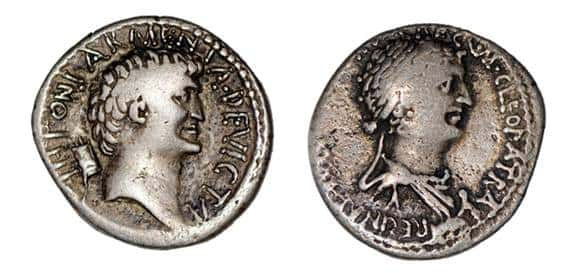Even today, over years after her death, Cleopatra remains one of history’s most intriguing and memorable women. The Egyptian Queen commanded her own army, enamored not one but two Roman rulers, and inspired countless works of art, literature, and film. Her prowess as a ruler made her legendary, and the stories of her romances with Julius Caesar and Marc Antony made her unforgettable. Here are 46 Dazzling Facts about Cleopatra, Queen of the Nile.
46. Not The First
When you say “Cleopatra” in modern times, there’s only one Queen of the Nile most people think of, but Cleopatra was actually the seventh woman in the Ptolemaic dynasty to bear that name. She’s officially known as Cleopatra VII Philopater. For this article, however, we’ll just be calling her “Cleopatra”.
45. What’s in a Name?
The name “Cleopatra” (in Greek “Κλεοπάτρα”) means “she who comes from glorious father.”
44. Foreign Influence
Why would an Egyptian queen bear a Greek name, you ask? Why, it’s because she was Greek. Cleopatra’s family, the Ptolemies, migrated to Egypt from Greece. So while Cleopatra was born in Egypt, she was, in fact, Macedonian Greek by origin.
43. The Beauty Myth
The name “Cleopatra” has become synonymous with exotic beauty and allure, but the real Cleopatra’s beauty was further down the list of her charms. Coins showing her face display a somewhat homely woman with a hooked nose. She likely made herself appear more masculine in looks and in manner, in order to project a more powerful countenance.
42. But Don’t Just Take Our Word For It
In fact, of her looks, Plutarch wrote, “her beauty, as we are told, was in itself neither altogether incomparable nor such as to strike those who saw her.” Rather, it was the whole package—her wit, her charm, and (again, according to Plutarch) “sweetness in the tones of her voice” that made her so irresistible.
41. Smear Campaign
The reputation Cleopatra acquired as a brazen beauty and irresistible temptress is far from a modern construct—accounts from ancient Roman history depict Cleopatra using her feminine charms to bewitch and influence powerful men of the ancient world. Her wit and intelligence were often downplayed or overshadowed entirely by her sexiness in accounts written by her Roman critics.
40. She Died Young
Cleopatra was born in 69 BC and died by suicide in August of 30 BC. She was only 39 years old when she died.
39. In Perspective
When Cleopatra was born in 69 BC, just over 2,100 years ago, it was at the end of the Egyptian Pharaoh dynasties and the beginning of a new phase in Egyptian history. The era of the Pharaohs was almost incomprehensibly long—the first dynasty of Egypt began in 3100 BC—over 5,000 years ago. The Great Pyramids at Giza were constructed between 2550 to 2490 BC. This means that Cleopatra lived closer to the time of the Moon landing than she did to the construction of the pyramids.
38. Native Tongue
Cleopatra was the first Ptolemaic ruler who learned to speak and write in Egyptian. For 300 years, her family spoke only Greek, so court documents, including the Rosetta stone, were bilingual—written in both in Greek and Egyptian. For those 300 years, the person ruling the Egyptians didn’t even speak their language.
37. Your God or Mine?
In addition to being the first ruler to speak the language of the Egyptians, Cleopatra was also the first in 300 years to embrace Egyptian culture and customs, including worshipping traditional Egyptian gods rather than those of the Greek religion.
 YouTube
YouTube
36. Taking It Even Further
Cleopatra not only adopted the Egyptian religion and worshiped traditional Egyptian gods, she believed she was one of them. Cleopatra fancied herself the reincarnation of the Egyptian goddess Isis.
35. Close Relations
Cleopatra’s father was Pharaoh Ptolemy XII. Her mother was likely Cleopatra V Tryphaena. As a custom amongst royalty at the time was to intermarry in order to consolidate power and money within families, Cleopatra’s parents were likely siblings or close cousins.
34. Polyglot
Cleopatra not only spoke Greek and Egyptian. According to the poet Plutarch, she spoke at least nine languages. Because of this, she could speak to generals and rulers of other countries without an interpreter, which would have given her an upper hand.
33. Young Queen
When Cleopatra was 14, her mother died under mysterious circumstances. Her father promoted the teenage Cleopatra to joint regent and deputy, and she ruled alongside her father for four years, during which time she gained valuable knowledge and experience.
 Dead Sea
Dead Sea
32. Keeping it in the Family
When Cleopatra’s father, Pharaoh Ptolemy XII, died, his will made 18-year-old Cleopatra and her 10-year-old brother joint rulers. A per custom, she was forced to marry her brother.
 cambodiaexpatsonline
cambodiaexpatsonline
31. Sibling Rivalry
Within months of taking the throne, Cleopatra made it clear she had no interest in sharing power with her younger brother. Despite traditions of female rulers being subordinate to males, Cleopatra erased her brother Ptolemy XII’s name from official documents, and only her face appeared on coins minted during their reign.
30. Dry Reception
The first three years of Cleopatra’s reign were tough. When Cleopatra took the throne, Egypt was already beset by a terrible drought—low Nile flooding meant that crops failed, trade suffered, people went hungry, and less money was made. Political unrest caused by the bad conditions made a coup against Cleopatra almost inevitable.
29. Dethroned
In 50 BC, only a year after she ascended to the throne, Cleopatra became embroiled in a dispute between Roman troops and a Syrian governor. When Cleopatra sided with the Syrians, the Romans retaliated by helping her husband-brother Ptolemy XIII steal the throne from her.
28. A Second Defeat
Cleopatra wasn’t about to give up her throne that easily—after a coup installed her brother as ruler, she drummed up mercenaries, formed an army, and fought against her brother’s army at Pelusium. After losing the battle, Cleopatra was forced to flee, along with her sister, Arsinoe IV.
27. Diplomatic Scuffle
Cleopatra’s younger brother Ptolemy XIII now sat on the Egyptian throne at only 13 years old, and he ruled with all the maturity and tact one would expect from a 13-year-old. After he ordered the execution of Pompey, one of Julius Caesar’s Roman political enemies, in front of Pompey’s own wife and children, Caesar, then ruler of Rome, was enraged. Caesar seized the Egyptian capital and instilled himself as arbiter between the opposing claims of Cleopatra and Ptolemy XII to the Egyptian throne.
26. On Screen
Cleopatra has been depicted in film many times, played by screen sirens such as Sophia Loren and Claudette Colbert, but the 1963 blockbuster Cleopatra has become the definitive version. Cleopatra starred Elizabeth Taylor and Richard Burton, who in real life had a love affair tumultuous enough to envy that of Antony and Cleopatra. The film clocked in at 248 minutes (over 3 hours) and was made with a budget of $44 million—including $200,000 for Taylor’s costumes alone. With inflation, Cleopatra remains one of the most expensive and extravagant films ever made.

25. Age Difference
After Rome invaded, Cleopatra devised a way to meet Caesar (more on that later), and the two became lovers. At the time, Caesar was 52 years old, and Cleopatra was 21.
24. Love Child
Despite their 31-year age difference, Cleopatra and Julius Caesar were lovers for two years. In 47 BC, Cleopatra gave birth to his son, Ptolemy Caesar, who was nicknamed Caesarion, or “little Caesar.” And now I want pizza.
23. Illegitimate
Caesar was already married and had children, and so despite Cleopatra’s wish that their son be named heir and successor to Caesar, he refused. Instead, he named his grand-nephew Octavian—who ruled under the name Augustus—as his successor instead.
22. Leap Years
Anyone born on February 29 has Cleopatra to thank for having an unconventional birthday. During Cleopatra’s relationship with Caesar, she introduced him to her astronomer, Sosigenes of Alexandria. It was Sosigenes who proposed the idea of leap years and leap days. Caesar adopted the idea and reformed the Roman calendar in 45 BC. The Egyptian calendar followed suit in 26 BC.
 Hudson Valley Geologist - Blogspot
Hudson Valley Geologist - Blogspot
21. Not Her Sister’s Keeper
Though they were forced to flee from Egypt together after Cleopatra was dethroned by her brother Ptolemy XII, Cleopatra and her sister Arsinoe IV had a fraught relationship. Fearing Arsinoe was plotting to take over the throne herself, Cleopatra had Arsinoe murdered on the steps of a temple in Rome. This caused a scandal, as it was a gross violation of temple rules, not to mention that it was a heinous act.
20. Trend Setter
Cleopatra’s arrival in Rome with her lover, Caesar, caused quite a stir. In addition to the affair setting tongues wagging, Cleopatra became a fashion and beauty icon amongst Roman women. She wore the hairstyle of her Greek ancestors, with her hair braided into a bun. Upon her arrival, this hairstyle was adopted by Roman women along with Cleopatra’s makeup and signature pearl jewelry.
19. A Goddess on Earth
While in Egypt, Cleopatra fancied herself the reincarnation of the Greek goddess Isis, and in Rome she allied herself with Venus, the goddess of love (known in Greek mythology as Aphrodite). Caesar commissioned a gold statue of Cleopatra, which was erected in the temple of Venus in Rome. This was seen amongst many Romans as sacrilege, which didn’t improve Cleopatra’s position.
18. Et Tu, Brutus?
Cleopatra’s time in Rome came to an end when Julius Caesar was stabbed to death in 44 BC. She fled Rome and returned to Egypt. Caesar was succeeded by a three-man dictatorship consisting of Caesar’s grand-nephew Augustus, his general Marcus Aemilius Lapides, and Marc Antony.
17. Bad Sister
Cleopatra’s brother (and husband) Ptolemy XIII drowned in the Nile River during a battle with Cleopatra’s and Caesar’s army in a bid to restore her to the throne. After the war, she remarried her younger brother Ptolemy XIV to consolidate power, but later had him murdered so her son could rule as co-regent. Along with her sister, Arsinoe IV, she had a hand in the deaths of three of her siblings.
16. A Grand Entrance
Cleopatra's meeting Marc Antony was truly dramatic. When she was summoned to meet the Triumvirate (aka the three men who now ruled Rome), she sailed down the Nile on a golden barge adorned with purple sails and silver oars. Cleopatra, dressed as the goddess Aphrodite, arrived to meet Marc Antony. An impressive move, and one that endeared herself to Marc Antony, who fancied himself to be an embodiment of Dionysus, the Greek god of wine and revelry.
15. Partners in Love
Despite two marriages (to her brothers) and an affair with a man 31 years her senior, it was when Cleopatra met Marc Antony that she found true love. The pair became lovers in 41 BC, and returned to Alexandria together. They were inseparable—they hunted together, drank together, played dice together, and she watched while he performed military exercises. They stood together as partners against Egypt’s enemies, and were married in an Egyptian ceremony—despite the fact that Antony already had a wife in Rome.
14. The Couple That Drinks Together…
Cleopatra and Marc Antony must have had some grand times together, in the true Dionysian style. The pair even started a drinking club—the society of “Inimitable Livers”—which indulged in feasts and wine-binges, and engaged in elaborate games and contests. According to lore, Cleopatra and Marc Antony enjoyed dressing up in disguise and wandering Rome while playing pranks on its unwitting citizens.
13. Pearls Before Romans
In one of Antony and Cleopatra’s elaborate contests, she bet him that she could throw the most expensive dinner in history. After an unremarkable first course, Antony mocked her attempt. However, when served his second course, he was shocked to discover that his dish contained only strong vinegar. Cleopatra plucked a pearl from her earrings and dropped it into the vinegar, wherein it began to dissolve, and promptly gulped it down.
12. That Had to Be a Huge Pearl
The other earring was cut in two, and each half was used to adorn the sculpture of Venus in the Pantheon. This story was told by the historian Pliny the Elder in his Natural History, written in 79 AD. According to his estimate, the pearls were worth 60 million sestertii—roughly $28.5 million dollars today.
11. The Original Celebrity Baby Names
Cleopatra and Marc Antony had three sons together: twins named Cleopatra Selene and Alexander Helios (that’s right, twins named Sun and Moon), and a son named Ptolemy Philadelphus. Yes, that's Ptolemy the brother-lover.
10. At War
Relations between Marc Antony and Octavian were breaking down. Antony was declared a traitor, and ridiculed in Rome for “going native”—adopting Egyptian customs which Rome deemed uncivilized. Cleopatra was smeared by Octavian as a scheming seductress who had used her feminine wiles to entrap one third of the Triumvirate. In 33 BC, Rome declared war on Egypt.
9. Warrior Queen
Never the shrinking violet, Cleopatra was presented with her own fleet of warships during the Battle of Actium in 31 BC. She personally led her fleet of over a dozen ships along side Antony’s own. Alas, they were outnumbered, and after losing the battle were forced to flee to Egypt.
8. By Her Own Hand
According to sources from the ancient world, including various Roman historians and poets, Cleopatra died by her own hand. The most common story is that she induced an asp (an Egyptian cobra) to bite her. She died in Alexandria in 30 BC, at age 39. However, there are many stories of Cleopatra’s death. Other historians suggest she may have swallowed poison, or stabbed herself with a pin dipped in snake venom.
7. Like Romeo & Juliet
Upon hearing of Cleopatra’s death, Marc Antony took his own life by stabbing himself in the stomach. Other stories, including the Roman historian Plutarch’s account, suggest that Antony heard a rumor of Cleopatra’s death and killed himself, only to find out she was still alive. He was brought to her and died in her arms, upon which time she also committed suicide. As wrote Plutarch, “what really took place is known to no one.”
6. Lost to History
The tomb of Cleopatra and Marc Antony has never been found, though the Egyptian Antiquities Service believes it to be in or near the temple of Taposiris Magna, southwest of Alexandria. Archaeologists continue to the search to this day.
5. Tribute
When the Roman leader Octavian was offered a chance to name a month in his honor, he chose August, the month he defeated Cleopatra, instead of his September birth month, as his success was founded on her loss. He took the name Emperor Augustus, and he carried a statue of her through Rome's streets every August in triumph.
4. A Love Story for the Ages
The story of Antony and Cleopatra, with its perfect blend of drama, politics, and romance, has captivated imaginations throughout history to the present day. In Ancient Rome, the story was told and retold by historians like Plutarch and Pliny the Elder, along with countless dramatists and poets. Cleopatra has been a popular subject in art, and many statues and paintings depict her, as well as moments from her life and death. She’s been the subject of seven ballets, 25 films, has had a comet named after her, and Kim Kardashian posed as Cleopatra in a 2011 issue of Harper’s Bazaar.
3. Bard’s Honor
William Shakespeare often drew upon history in his plays, and Cleopatra’s influence appears in two of the bard’s most famous works. The protagonists’ tragic deaths of Romeo & Juliet bear an unmistakable similarity to those of Antony and Cleopatra. This trope features again in Antony & Cleopatra, Shakespeare’s play based on the story of their lives as told by Plutarch. Many consider Shakespeare’s Cleopatra to be the most complex well-developed of all his female characters.
2. That's One Way to Make an Entrance
Cleopatra, clever and charming, certainly knew how to make an entrance. In order to meet Caesar face to face, in hopes of enticing him over to her side, she had herself smuggled through enemy lines while rolled up in a carpet, which was brought to Caesar’s private quarters. When unrolled, she charmed Caesar and the two became allies. In 48 BC, Caesar fought for Cleopatra in a four-month war against Ptolemy and regained the Egyptian throne for Cleopatra.
 urancientworldincinema.wordpress
urancientworldincinema.wordpress
1. Egypt’s Last Pharaoh
Cleopatra’s reign would have been a tough act to follow, and as it happened, no one did. After her death, the history of Egypt’s great dynasties fell away, and in 30 BC, the country disappeared under the sandal of Rome, becoming a mere province of the great Roman Empire. Cleopatra’s legacy remains as the last true Queen of Egypt.
 Wikipedia
Wikipedia
Sources: 1, 2, 3, 4, 5, 6, 7, 8, 9, 10, 11, 12, 13, 14, 15, 16, 17, 18, 19, 20, 21, 22, 23

















































